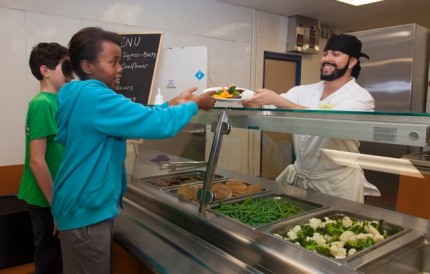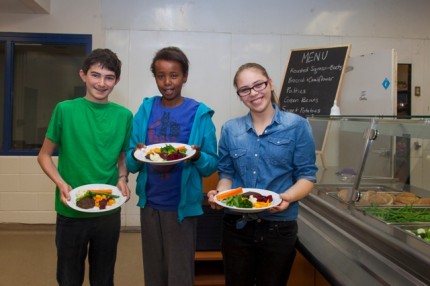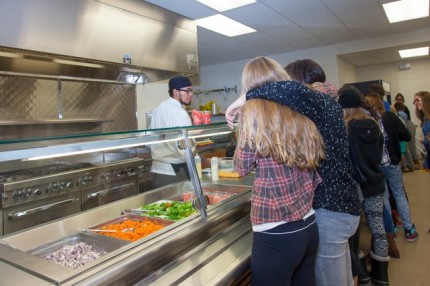A model for healthy food in Ontario Schools: FoodShare’s Good Food Café
Posted: January 19, 2015
Categories: Edible Education Network / Edible Education Project Profiles / GoodFoodBites / News from Sustain Ontario

Photo taken by Laura Berman, Greenfuse Photography
Good healthy food for all – this is the mandate in which FoodShare bases all of their work.
Working with communities and schools since 1985 to deliver healthy food and food education, FoodShare has a number of projects and initiatives that work to increase access to affordable high-quality fresh food.
Alvin Rebick, Kitchen and Good Food Program Senior Manager, talked with us about FoodShare’s Good Food Café in particular, which has grown in various forms since it began as a pilot project 5 years ago, with the concept to reanimate school food and school cafeterias.
By working with a variety of stakeholders, including nutritionists and dietitians, they set out to be a responsible model for introducing healthy food in Ontario schools – something some schools were desperate for, especially after the new School Food and Beverage Policy (PPM 150) was introduced in 2011.
Alvin explains the notion that children don’t like healthy food is just plain inaccurate. Children will eat good food, it just has to be introduced to them in an appealing way (and from the younger the age, the better). Through plenty of experimentation, FoodShare came up with ideas the students would like – they even did sampling and taste testing before entering some schools, allowing the students to be the ‘judges’, tasting their food offerings and picking what they liked. Student engagement is undoubtedly of great importance; at College Francais, for instance, they began a cooking club to get the students more actively engaged in healthy eating. Alvin recalls that when the students started cooking, it changed their attitude toward healthy food.
The Good Food Café is currently in 5 Toronto schools – in 3 high schools they are the resident cafeteria, actually having taken over the cafeteria and serving students daily; while in 2 other schools (one elementary school and one high school) they are a food provider, dropping food off as a commissary. The commissary model operates one day or so a week, with parents ordering the food in advance (they’re always sure to include extra for those who can’t afford it, too). This reach connects them with Toronto’s 4 school boards: the Toronto District School Board, the Toronto Catholic District School Board, the Toronto French Board, and the Toronto French Catholic School Board. The hope is to expand, with intentions to be in a JK-6 school in January.
Alvin explains that it’s not just about accessing students and getting healthy food in schools, which of course is fundamental, but it’s also about serving as a model program that others can replicate, and to advocate for healthy school food in general, showing that it can be done: this is how. It’s about addressing the issue of hunger through the school system, reducing child poverty, improving children’s nutrition and advocating for a national school meal program (Canada is the only G8 country without a nationally-funded school meal program).
Among healthy salads, burritos, chicken, potatoes, chilli or lasagna, the Good Food Café has significantly increased fruit and vegetable consumption in the schools they’re in. It’s clear that the more kids are exposed to the healthy options, the more they chose it. This pattern should surely demonstrate how imperative it is for kids to have access to healthy food from a young age.

Photo taken by Laura Berman, Greenfuse Photography
And it’s evident FoodShare has taken the time to build relationships and connections with the schools and students. Alvin shares the strength of their relationship at the first school where they took residence. It’s evident the kids trust them, resulting in much more adventurous eaters; their 70% spinach burger illustrates the point. They tried the spinach burger at a new school, before quickly realizing they had to pull back and introduce new foods more gradually.
It’s a learning experience, like anything, and growing relationships with the kids and schools is something the Good Food Café has ultimately championed.
Below, Alvin offers some more knowledge into FoodShare’s appetizing Good Food Café:
How is the Good Food Café funded?
- A variety of funding support; a couple of grants (e.g. Heart and Stroke Foundation, Ministry of Education)
- Being a social enterprise, it’s also self-sustaining – we sell the food to the kids at a very reasonable price (this year’s sales are over $75, 000)
- Miziwe Biik, an aboriginal employment agency, provides staff on a contract basis
How did you first engage and connect with the schools?
This is a very parent-driven initiative. In 2009, a grade 7 and 8 french school moved into
FoodShare’s 90 Croatia St location, and it was the parents that suggested FoodShare be
the school’s cafeteria food provider. With food security and healthy food access at our core,
we jumped on the opportunity.
This is how the Good Food Café began, and with great success, so it’s really just taken off
from there. Next, a joint public and French school on Lansdowne (with a joint cafeteria)
asked us to be their food provider. Relationships sprout new ones; after this we joined on
with the Catholic French Board. And with the commissary model, the parents really brought
us into the public school as well.
Establishing relationships with the various school boards has been key.
What tips do you have for others?
- Have a clear mission from the beginning and stay true to it
- Be clear from the beginning what you can (and cannot) offer
- Do your research for not only affordable food, but also culturally appropriate food
- Be reasonable with your expectations and what you can and cannot do (we have had to turn down opportunities when we simply haven’t had the resources)
- Parent involvement, especially in JK-8 schools, is crucial
- Have menus designed and be flexible and curious what the students want – let the menu reflect their interests (FoodShare supplies recipes and menus)
- Student engagement is crucial to get kids interested
We always try to remain open-minded and be creative with new ideas, e.g.:
A food alternative without a kitchen – In the new year we are going to do a street food cart at one school to model healthy street food (Mexican one week, Indonesian the next, Chinese another, and so on). This will allow us to serve good, culturally-interesting food without even having a kitchen. New, exciting ideas appeal to the kids and keep them interested, all while educating them about new foods.
What have been the biggest challenges and how did you address it?
- Having enough staff to produce the food
- With the commissary model, delivery can be a challenge (though fortunately we sometimes get volunteers who provide a vehicle – we’d love a vehicle donor!)
Through experimentation and student engagement we have recipes that we know kids will eat – time and experience reveal which dishes are best and most cost-effective.

Photo taken by Laura Berman, Greenfuse Photography
Essentially, having enough capacity to meet demands has been one of our biggest challenges. We’re here to model how it can be done, and hopefully pass on the knowledge. We manage what we can, and once we’re in the cafeterias, kids respond strongly. Our sales certainly demonstrate that and help sustain the program.
Contact:
Alvin Rebick
FoodShare Toronto
Kitchen and Good Food Program Senior Manager
alvin@foodshare.net
This profile is part of a series of profiles for the Ontario Edible Education Network.
Be sure to check out more profiles from the Network here!
